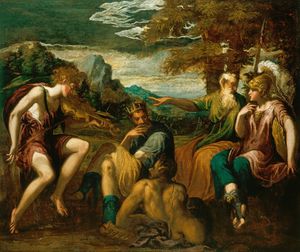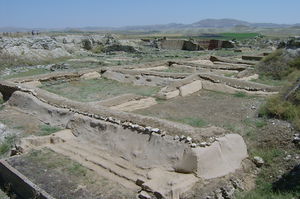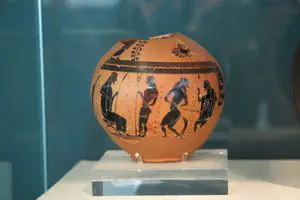Did Midas Really Have the Golden Touch
Most people today are somewhat familiar with the legend of King Midas and that he was said to have the “golden touch.” The legend has been turned into a familiar pop culture meme seen on cartoons and even adopted by an American automotive repair franchise, bringing it into the minds of millions of people who probably would not have ordinarily known anything about it. But few are aware of the legend’s historical origins.
The historical King Midas ruled the Near Eastern kingdom of Phrygia in the late eight and early seventh centuries BC, competing with the Assyrians for land and wealth in the region. The legend of King Midas turning everything he touched to gold was a literary story developed later by the Greeks and Romans and although obviously purely fictional, it was no doubt based on some degree of reality. An examination of the historical King Midas reveals that he was actually a strong and successful ruler who made Phrygia one of the most powerful and wealthy kingdoms in the early Iron Age Near East. King Midas may not have had a literal golden touch, but his successful rule was enough to inspire later Greek and Roman writers.
The Kingdom of Phrygia
Phrygian culture developed out of the Late Bronze Age collapse that took place around the year 1200 BC, as one of the first cultures to bring civilization back to Anatolia (modern Turkey) after the Hittite Empire was destroyed. The Kingdom of Phrygia was located northeast of Lydia, west of the Halys River, and north of Cappadocia, with its capital city of Gordium located along the banks of the Sangarius River. The exact location of the kingdom, though, was somewhat fluid because borders between kingdoms and peoples in ancient Anatolia were not as defined as they are today.
For instance, the Greeks considered there to be a Greater and Lesser Phrygia and the Persians essentially considered the Phrygians and Lydians as the same peoples because they were neighbors and shared a similar culture. [1]
Although the linguistic background of the Phrygians remains somewhat of an enigma, many scholars believe that Phrygian was an Indo-European language that developed out of Hittite, which was the dominant language in the region until 1200 BC. [2] Besides some linguistic similarities between Hittite and Phrygian, the fact that Phrygia developed after 1000 BC in the former area of the Hittite Empire and was close in proximity to the Lydians, who did speak an Indo-European language, are points in favor of the Phrygians’ Indo-European background. Still, some modern scholars argue that although Phrygian may be determined to be Indo-European at some point, the evidence is not conclusive. [3]
Although the nature of the Phrygian language is still to be determined, modern excavations of Gordium have proved that the Phrygians had a written language before 700 BC. [4] Most of the earliest Phrygian writing was discovered in and around religious sites in short inscriptions, often on vases. It is not known for sure, but the Phrygians probably based their written language on the Greek script. [5]
Unfortunately, there is no known complete, extant Phrygian religious text, but a combination of modern archaeological work at Gordium and references by later Greek writers helps shed some light on their religion. Phrygian kings were buried in large tumuli burial mounds, which were quite common throughout ancient Anatolia and indeed among nearly all ancient Indo-European peoples. [6] In terms of daily religious practices, far less is known about the Phrygians. According to the first century BC Greek historian, Diodorus, the primary deities of the Phrygians were the goddess Cybelle and the god Attis. [7] By the middle of the eight century BC, all the hallmarks of Phrygian culture had long been in place and it was the premier kingdom in Anatolia, involved in trade and diplomacy with the Greeks and Assyrians and also at time war with the latter.
The Mythological King Midas
The Greeks were the first people to relate myths concerning King Midas’ golden touch, but the very way in which Midas became king is shrouded in myth and mystery. One of the most complete Midas origin legends was written by the second century AD Greek historian, Arrian. According to the historian, Midas’ father, Gordius, witnessed a miraculous event when an eagle perched on one of his wagons. An oracle told him to offer to Zeus at the site, which he did and also married the oracle who gave birth to Midas. Years later, the prophecy was fulfilled when Midas became king of the Phrygians.
“Now when Midas had grown to be a fine and handsome man there was trouble and strife among the Phrygians, and an oracle told them that a wagon would bring them a king, who would put an end to their quarrels. While they were still debating what to do about these things, Midas with his father and mother drove up in the wagon and came to a stop at their place of meeting. Taking this to be the fulfilment of the oracle, the Phrygians decided that here was the man whom the god had foretold that a wagon would bring. So they put Midas on the throne, and he made an end of their trouble and strife and laid up his father’s wagon on the acropolis as a thank-offering to Zeus the King for sending the eagle.” [8]

According to this legend, Midas may not have had the literal touch of gold, but his ascension to the throne was otherworldly and he did display a metaphorical golden touch by bringing different factions of Phrygians together. The legend of Midas’ golden touch, though, was retold in different legends, one of the most memorable being in Ovid’s Metamorphoses.
Ovid was a Roman poet and writer who lived during the era of the Roman Civil Wars in the first century BC. His lengthy Latin poem survived the Dark Ages and became the basis for the modern versions of the King Midas story. One chapter of Metamorphoses is dedicated to the Phrygian king’s desire to have the golden touch and his ultimate regret of its power.
“Bachhus, rejoicing in the safe return Of old Silenus (once his guardian). Granted the king to choose his heart’s desire. A choice that seemed a boon, but proved a bane. So Midas chose, a sorry choice: ‘Ordain That everything I touch shall turn to gold.’ The god indulged his wish, gave the reward, Dire as it was, and mourned a choice so bad.” [9]
The Historical King Midas
Although the mythical and legendary stories of King Midas are fantastic to say the least, like all legends they are based on some degree of reality. Modern historians generally consider Midas’ rule to be the highpoint of Phrygian culture, which is based on the material culture discovered in excavations and references to the king and his kingdom in Greek, Assyrian, and even biblical texts. The fifth century Greek historian, Herodotus, mentions King Midas in a passage that demonstrates the political and cultural influence he had in the region at the time as well as his wealth.
“Gyges was the first foreigner we know of, after King Midas of Phrygia, son of Gordias, to dedicate offering at Delphi. Midas presented the royal throne from which he used to give judgement; it stands with Gyges’ bowls, and is well worth seeing.” [10]
The fact that Midas, a non-Greek, dedicated his own throne to the Oracle of Delphi certainly demonstrates that he and his kingdom were wealthy. The wealth of Phrygia is further corroborated in a passage from the Old Testament of the Bible where Meshech, which is believed by modern scholars to have been the Hebrew word for Phrygia, was described as “they merchant: they traded the persons of men and vessels of brass in thy market” (Ezekiel 27:13). The Phrygians are also mentioned in the Assyrian annals as a perpetual problem for the mighty empire.
Annals dated to the reign of the Assyrian King Sargon II (721-705 BC), which was contemporary with the reign of Midas, indicates that the Phrygians, referred to as “Mita” by the Assyrians, had problems with their neighbors the Cilicians, while still maintaining a degree of independence.
“My official, the governor of Kue (Cilicia) made a raid against Mitâ, who had not made his submission to the king who went before me, without changing his mind (i.e., he had not consistently refused submission), sent his messenger to me, to the sea of the rising sun (where I was), (offering) to do (feudal) service and to pay (bring) tribute and gifts." [11]
The disputes that Midas had with the Assyrians began to take their toll on the wealthy, yet relatively small kingdom. After Midas’ death, his successors were unable to effectively deal with the repeated conflicts with Assyria and attacks from semi-nomadic peoples such as the Cimmerians. The result was the dominance of the Kingdom of Lydia in Anatolia by the seventh century BC, leaving Phrygia as just another backwater that was ruled over by successive powers. [12]
Conclusion
King Midas was one of the greatest kings of the early Iron Age Near East, as his leadership and policies helped make the Kingdom of Phrygia among the wealthiest and most powerful at the time. It is no doubt because of his success as a monarch that the Greeks and Romans later attributed fantastic, legendary stories to Midas, the most well-known being that everything he touched turned to gold. Although King Midas may not have literally had the “golden touch,” he was certainly very successful in his political and economic endeavors.
Suggested Readings
- Mellink, M. “The Native Kingdom of Anatolia.” In The Cambridge Ancient History. Edited by John Boardman, I.E.S. Edwards, N.GL. Hammond, E. Sollberger, and C.B.F. Walker. Second Edition. Volume 3 part 2. (Cambridge: Cambridge University Press, 1999)
- Herodotus. The Histories. Translated by Aubrey de Sélincourt. (London: Penguin, 2003)
- Arrian. The Campaigns of Alexander. Translated by Aubrey de Sélincourt. (London: Penguin Books, 1971)
- Diodorus. The Library of History. Translated by C.H. Oldfather. (Cambridge, Massachusetts: Harvard University Press, 2004)
- Kuhrt, Amélie. The Ancient Near East: c. 3000-330 BC. (London: Routledge, 2010)
References
- ↑ Mellink, M. “The Native Kingdom of Anatolia.” In The Cambridge Ancient History. Edited by John Boardman, I.E.S. Edwards, N.GL. Hammond, E. Sollberger, and C.B.F. Walker. Second Edition. Volume 3 part 2. (Cambridge: Cambridge University Press, 1999), pgs. 626
- ↑ Masson, O. “Anatolian Languages.” In The Cambridge Ancient History. Edited by John Boardman, I.E.S. Edwards, N.GL. Hammond, E. Sollberger, and C.B.F. Walker. Second Edition. Volume 3 part 2. (Cambridge: Cambridge University Press, 1999), pgs. 699-70
- ↑ Kuhrt, Amélie. The Ancient Near East: c. 3000-330 BC. (London: Routledge, 2010), p. 566
- ↑ Mellink, p. 625
- ↑ Masson, p. 667
- ↑ Mellink, pgs. 631-2
- ↑ Diodorus. The Library of History. Translated by C.H. Oldfather. (Cambridge, Massachusetts: Harvard University Press, 2004), Book III, 58-59
- ↑ Arrian. The Campaigns of Alexander. Translated by Aubrey de Sélincourt. (London: Penguin Books, 1971), Book II, 3
- ↑ Ovid. Metamorphoses. Translated by A. D. Melvile. (Oxford: Oxford University Press, 2008), XL, 96
- ↑ Herodotus. The Histories. Translated by Aubrey de Sélincourt. (London: Penguin, 2003), Book I, 14
- ↑ Luckenbill, Daniel David, ed. and trans. Ancient Records of Assyria and Babylon. Volume 2. (London: Mysteries of Man, 1989), p. 36
- ↑ Kuhrt, pgs. 565-7


